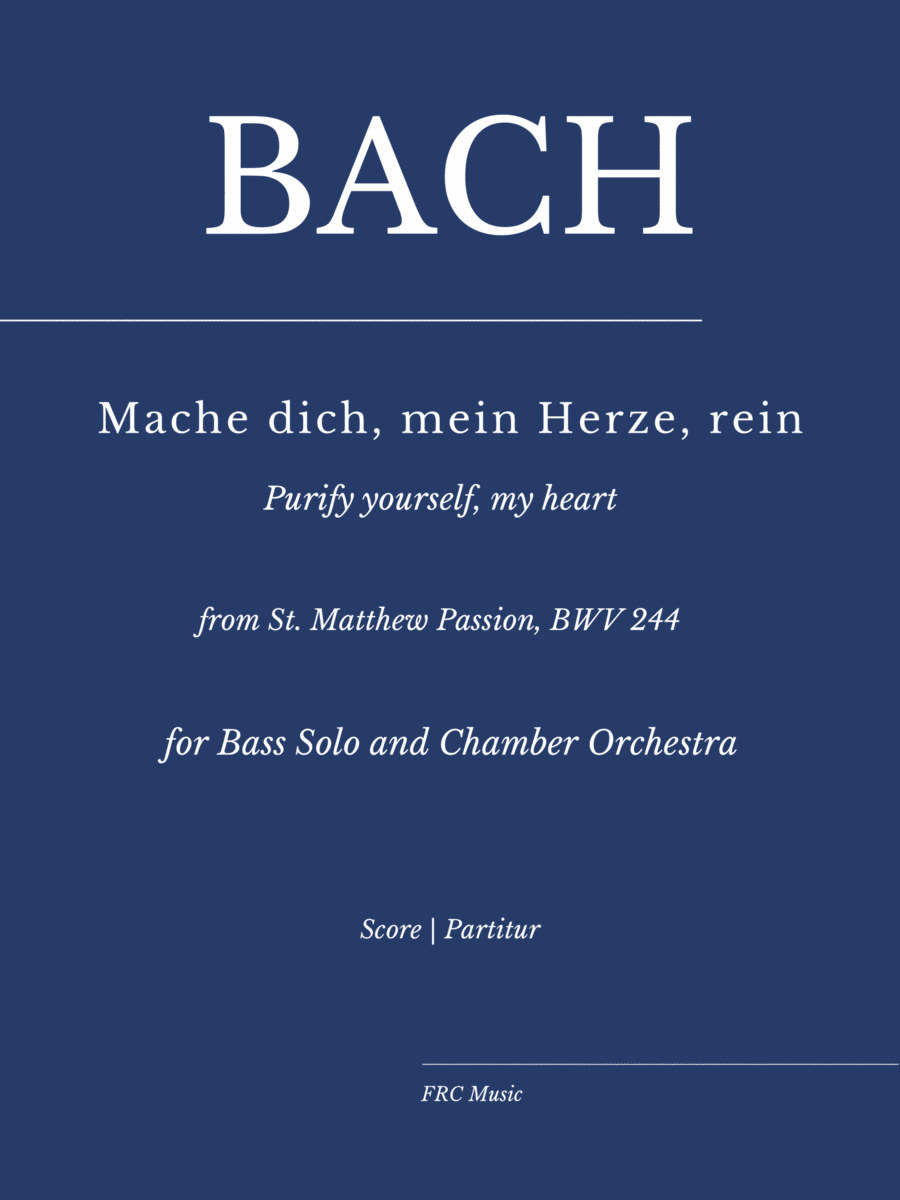Chamber Orchestra - Level 4 - Digital Download SKU: A0.1283479 By Johann Sebastian Bach and Netherlands Bach Society. By Johann Sebastian Bach. Arranged by Flavio Regis Cunha. Baroque,Contest,Easter,Festival,Instructional,Sacred. Score and Parts. 51 pages. Flavio Regis Cunha #874665. Published by Flavio Regis Cunha (A0.1283479). Bach: Aria 'Mache dich, mein Herze, rein' for Bass Solo and Chamber Baroque Orchestra from the St Matthew Passion (BWV 244).Discover timeless music with the Bach classic - 'Mache dich, mein Herze, Rein'! Enjoy the intricate and vibrant performance of the piece from the renowned Netherlands Bach Society. Perfect for both professional orchestras and soloists – as well for the joy of schools performing the revered composer's masterpiece. Get the perfect accompaniment for your performance with the authentic sheet music available now!The aria 'Mache dich, mein Herze, rein' from the St Matthew Passion (BWV 244), performed here by the Netherlands Bach Society and conducted by Jos van Veldhoven for All of Bach. The St Matthew Passion tells the story of the last days of Jesus. He is betrayed, tried, crucified and buried. The lyrics were compiled by Picander (the pseudonym of Christian Friedrich Henrici), probably in close consultation with Bach himself. For their theme, they took the story as told by St Matthew the Evangelist. As different groups or people have their say, the singers get different roles – Christ, Judas, Peter, a slave girl, the pupils, the high priests, the people and the soldiers, etc. At key moments in the story, Bach and Picander added chorales and arias as a reflection of the biblical story. The action is suspended and the events are placed in the theological context of Bach’s day. The chorale lyrics and melodies come from the Lutheran hymn book, and were well known to the congregation in Leipzig. Even though Bach’s harmonies were new, everyone would have recognised the melody and the words. The lyrics for the opening and closing choruses and the arias were brand new, however. Both the arias and the chorales often link up seamlessly with the evangelical words. Advanced IntermediateFormat: Concert, 9 x 12 inches51 pagesProgram NotesMache dich, mein Herze, rein is a deeply poignant and emotional piece from the renowned work by Johann Sebastian Bach, St Matthew Passion (BWV 244). Written as a part of the 16th passion oratorio as a love song sung by Jesus to his disciples, this piece brilliantly conveys the struggle of redemption and longing for peace.Accompanied by a chamber baroque orchestra, the stark vocal line is delivered with an intense intricacy by the bass solo. Each note is carefully laden with sincere emotion, imbuing within the words a sense of longing and deep sorrow. As the piece progresses, the reprise of the chorus adds a layer of reflection to the message, driving home the power of the connection between Christ and his disciples.Mache dich, mein Herze, rein is a highly moving and truly remarkable piece of music that has rightly earned a place amongst Bach's most renowned works. Mache dich, mein Herze, rein is one of the most stunningly tender and moving chorales from Johann Sebastian Bach's monumental oratorio the St Matthew Passion (BWV 244). Originally written with a full choral accompaniment for the Easter Week Vespers of 1729, Bach's skilful reworking of the melody for bass and chamber baroque orchestra in the St Matthew Passion gives the solo voice a unique poignancy and fragility. The Lutheran chorale on which Bach based his composition speaks of hearts needing to be cleansed of sin and sorrow as they prepare to meet the Savior - an idea timeless in its poignancy and universality. Bach's arrangement is akin to a prayer of reflection and contemplation, the music's restrained dynamics and sighing counterpoint creating an atmosphere of resignation and acceptance. Mache dich, mein Herze, rein is a sublime masterpiece of sacred music, truly embodying the spirit of Easter.
